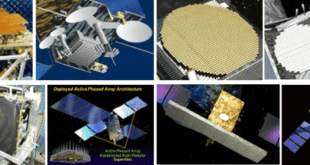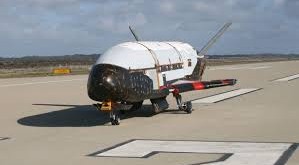Sensors are usually thought of in terms of physical devices that receive and respond to electromagnetic signals – from everyday sensors in our smartphones and connected home appliances to more advanced sensors in buildings, cars, airplanes and spacecraft. However present day physical sensors are severely limited in range to continuously and globally detect disturbances that take place on or above the earth’s surface.
To that end, DARPA recently announced its Atmosphere as a Sensor (AtmoSense) program, whose goal is to understand the fundamentals of energy propagation from the ground to the ionosphere to determine if the atmosphere can be used as a sensor. The atmosphere is comprised of layers based on temperature. These layers are the troposphere, stratosphere, mesosphere and thermosphere. A further region at about 500 km above the Earth’s surface is called the exosphere. We humans live in the troposphere, and nearly all weather occurs in this lowest layer. Most clouds appear here, mainly because 99% of the water vapor in the atmosphere is found in the troposphere. Air pressure drops, and temperatures get colder, as you climb higher in the troposphere.
The stratosphere extends from the top of the troposphere to about 50 km (31 miles) above the ground. The infamous ozone layer is found within the stratosphere. Ozone molecules in this layer absorb high-energy ultraviolet (UV) light from the Sun, converting the UV energy into heat. Unlike the troposphere, the stratosphere actually gets warmer the higher you go!
Above the stratosphere is the mesosphere. It extends upward to a height of about 85 km (53 miles) above our planet. Most meteors burn up in the mesosphere. Unlike the stratosphere, temperatures once again grow colder as you rise up through the mesosphere. The ionosphere is not a distinct layer like the others mentioned above. Instead, the ionosphere is a series of regions in parts of the mesosphere and thermosphere where high-energy radiation from the Sun has knocked electrons loose from their parent atoms and molecules. The electrically charged atoms and molecules that are formed in this way are called ions, giving the ionosphere its name and endowing this region with some special properties.
Weather and Climate monitoring sensors
The weather is monitored from space through weather satellites, a type of satellite that is primarily used to monitor the weather and climate of the Earth. Satellites can be polar orbiting, covering the entire Earth asynchronously, or geostationary, hovering over the same spot on the equator. Meteorological satellites see more than clouds: city lights, fires, effects of pollution, auroras, sand and dust storms, snow cover, ice mapping, boundaries of ocean currents, energy flows, etc. Other types of environmental information are collected using weather satellites. Weather satellite images helped in monitoring the volcanic ash cloud from Mount St. Helens and activity from other volcanoes such as Mount Etna. Smoke from fires in the western United States such as Colorado and Utah have also been monitored. El Niño and its effects on weather are monitored daily from satellite images. The Antarctic ozone hole is mapped from weather satellite data. Collectively, weather satellites flown by the U.S., Europe, India, China, Russia, and Japan provide nearly continuous observations for a global weather watch.
From ground scientists have used lidars (light detection and ranging) to study the atmosphere. A lidar is an instrument that uses short pulses of laser light to detect particles or gases in the atmosphere, like a radar bounces radio waves off rain drops in clouds. A telescope collects and measures reflected laser radiation, like a radar dish collects the radar signal, leading to a profile of the atmosphere’s structure along the path of the laser beam. Researchers can then determine the location, distribution, and nature of atmospheric particles and molecular species using an advanced lidar method called the Differential Absorption Lidar (DIAL) technique.
Different types of lidars measure different atmospheric properties. Scientists know that different molecules absorb light only at certain wavelengths. They can then tune laser pulses to different wavelengths to target the type of atmospheric molecule they want to study using the DIAL method. To measure water vapor, aerosols, and clouds, researchers use the LASE system. Scientists developed LASE as a prototype for a space-borne DIAL system
But DARPA wants the physical atmosphere itself may offer such a sensing capability, if it can be understood and tapped into. DARPA plans to use all the atmosphere layers for sensing. It’s well known that energy propagates from the Earth’s surface to the ionosphere, but the specifics of how that happens is not currently known enough to use the atmosphere as a sensor. Scientific literature has clearly documented that events like thunderstorms, tornadoes, volcanos, and tsunamis make big “three-dimensional wakes” that propagate to the upper reaches of the ionosphere and leave a mark there. Since that energy traverses several other layers of atmosphere – the troposphere, stratosphere, and mesosphere – on its way up to the ionosphere, the idea is to try and identify the disturbances the “wake” is making along its way to see if researchers can capture information to indicate what type of event caused it. The layer of very rare air above the mesosphere is called the thermosphere. High-energy X-rays and UV radiation from the Sun are absorbed in the thermosphere, raising its temperature to hundreds or at times thousands of degrees.
“We typically model, simulate, and measure properties in the troposphere, which is where terrestrial weather happens,” Lewis said. “But we don’t really make those measurements in the stratosphere or the mesosphere, or the bottom part of the ionosphere, because no one has really been keenly interested in it and it’s hard to get up there. Sometimes the mesosphere is even called the ‘ignorosphere,’ but we know that information traverses it, so we’re really looking for scientists and engineers with unique ways of potentially measuring different aspects of the atmosphere.”
“Maybe I don’t have to directly observe events like an earthquake or tsunami,” said Air Force Major C. David Lewis who is the AtmoSense program manager in DARPA’s Defense Sciences Office. “Perhaps I can learn what occurred from information in the atmosphere. I want to find out how much information is available, and if I can disaggregate the signal I’m interested in from other natural phenomena creating noise in the background.”
Yet because DARPA is a military research organization, it’s reasonable to assume that this line of inquiry will have military applications, as well. One of the military applications can be weather warfare. Weather has always affected military operations, and as the climate changes, the way we execute operations may be altered or constrained. It will enable US DOD to predict weather for military applications and carry out weather modifications. It may enable them to detect nuclear weapons testing which might also leave fingerprints in the atmosphere. Or bomb explosions, or perhaps artillery firing through detecting acoustic waves
AtmoSense Program
A Proposers Day is scheduled for February 14, 2020, in Arlington, Virginia.The AtmoSense program seeks proposers from the atmospheric science community, who have extensive experience in atmospheric modeling and simulation. Also of interest are experts offering very unique ways to measure atmospheric properties, such as the basic PV=nRT variables – pressure, volume, density, temperature, or derivatives of such. Beyond these basic atmospheric variables, the mesosphere and lower ionosphere provide electromagnetic opportunities for measurement due to their charged nature.
Another key area for the program is measuring and understanding background noise that weakens or destroys signals of interest.“When we think about the possible background entropy, there are jet streams, compression of the fluid, shear forces, Coriolis forces, etc.; all those things trigger some sort of turbulence that destroys information,” Lewis said. “When it comes to geophysical and meteorological sources of atmospheric disturbance there’s a frequency spectrum emitted from infrasound all the way up to the ultrasound. Some of those frequencies are more immune to atmospheric entropy than others, and those are what we’d like to capture.”
The program calls for two phases. The first phase is concept development (27 months), and the second phase is proof of principle field testing (12 months). If successful, AtmoSense could enable new ways in the future to identify and give insight into events such as earthquakes, tsunamis, storms, tornados, and asteroid activity.
 International Defense Security & Technology Your trusted Source for News, Research and Analysis
International Defense Security & Technology Your trusted Source for News, Research and Analysis

